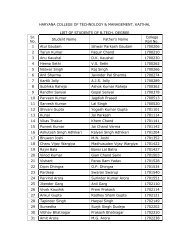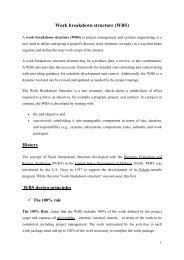You also want an ePaper? Increase the reach of your titles
YUMPU automatically turns print PDFs into web optimized ePapers that Google loves.
LECTURE NOTES OF ADVANCED DATA STRUCTURE (MT-CSE 110)<br />
Since all of the nodes of a level must be saved until their child nodes in<br />
the next level have been generated, the space complexity is proportional to the<br />
number of nodes at the deepest level. Given a branching factor b and graph<br />
depth d the asymptotic space complexity is the number of nodes at the deepest<br />
level, O(b d ). When the number of vertices and edges in the graph are known<br />
ahead of time, the space complexity can also be expressed as O( | E | + | V |<br />
) where | E | is the cardinality of the set of edges (the number of edges),<br />
and | V |is the cardinality of the set of vertices. In the worst case the graph has<br />
a depth of 1 and all vertices must be stored. Since it is exponential in the depth<br />
of the graph, breadth‐first search is often impractical for large problems on<br />
systems with bounded space.<br />
Time complexity<br />
Since in the worst case breadth‐first search has to consider all paths to all<br />
possible nodes the time complexity of breadth‐first search<br />
is which asymptotically approaches O (b d ). The time<br />
complexity can also be expressed as O (| E | + | V |) since every vertex and<br />
every edge will be explored in the worst case.<br />
Completeness:<br />
Breadth‐first search is complete. This means that if there is a solution<br />
breadth‐first search will find it regardless of the kind of graph. However, if the<br />
graph is infinite and there is no solution breadth‐first search will diverge.<br />
Proof of Completeness<br />
if the shallowest goal node is at some finite depth say d, breadth‐first<br />
search will eventually find it after expanding all shallower nodes (provided that<br />
the branching factor b is finite).<br />
Optimality<br />
For unit‐step cost, breadth‐first search is optimal. In general breadth‐first<br />
search is not optimal since it always returns the result with the fewest edges<br />
between the start node and the goal node. If the graph is a weighted graph, and<br />
therefore has costs associated with each step, a goal next to the start does not<br />
have to be the cheapest goal available. This problem is solved by improving<br />
Prepared By :<br />
Er. Harvinder Singh<br />
Assist Prof., CSE, H.C.T.M (Kaithal) Page ‐ 91 ‐







